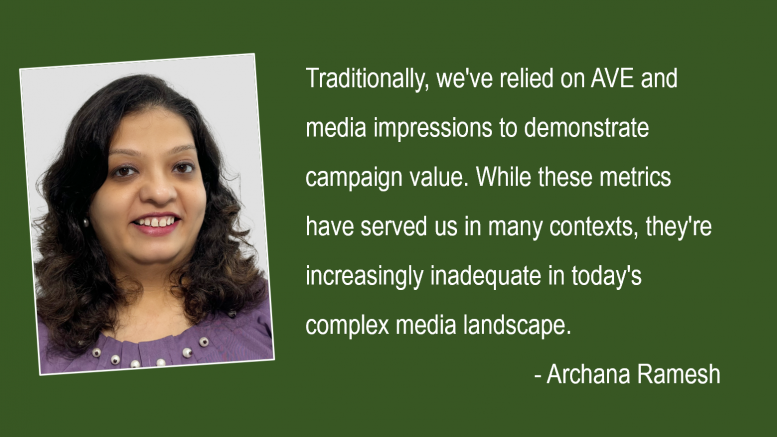In my 15 years in PR, I’ve witnessed a significant shift in how we measure success. Gone are the days when counting media clips or calculating Advertising Value Equivalency (AVE) sufficed. Today’s brands face scrutiny on multiple fronts—from social media chatter to sales figures—and our measurement techniques must evolve accordingly. It’s time we talk about why old-school metrics fall short and how more sophisticated approaches can finally prove PR’s true business value.
AVE and Media Impressions: The Old Guard’s Limitations
Traditionally, we’ve relied on AVE and media impressions to demonstrate campaign value. While these metrics have served us in many contexts, they’re increasingly inadequate in today’s complex media landscape.
AVE, a go-to metric for quickly conveying campaign value, has significant limitations. By treating all media coverage equally, regardless of source or context, it often misrepresents a campaign’s real impact.
I recall a campaign for a stock broking and trading company focused on user acquisition and engagement. When I presented our PR results using AVE, the founder asked point-blank, “But how does this translate to app downloads or daily active users?” It was a wake-up call. For data-driven businesses, AVE simply doesn’t address core concerns: Did the message resonate? Did it move the needle on brand perception?
Similarly, media impressions offer insights into potential reach but fail to capture the depth of audience engagement. In today’s digital age, where user interaction and brand perception are crucial, we need metrics that offer a more comprehensive view of campaign effectiveness.
As we move forward, we must complement these traditional metrics with targeted measures that address:
- How effectively our message resonated with the intended audience
- The impact of our efforts on brand perception
- How our campaign influenced user behavior or decision-making
A More Nuanced Approach: Sentiment, Share of Voice, and Message Penetration
To go beyond surface-level numbers, we need to embrace more sophisticated metrics:
- Sentiment Analysis: This tracks how people actually feel about your brand based on their comments across platforms. It’s critical because high attention doesn’t always mean positive impact. A campaign might generate buzz, but if the sentiment is negative, that attention could be doing more harm than good.
- Share of Voice (SOV): This advanced metric compares your brand’s coverage against competitors. If your brand has 20% of total media mentions in your industry while a competitor holds 40%, that’s a gap worth addressing. By tracking SOV, you’re not just chasing press—you’re strategically positioning your brand against the competition.
- Message Penetration: This takes things a step further by measuring if your key messages are actually being picked up and shared. It’s not just about getting mentioned; it’s about ensuring your intended narrative reaches the audience. For instance, if you’ve launched a campaign focused on sustainability efforts, message penetration helps you see if that’s the story the media—and more importantly, your audience—is walking away with.
Using Data Analytics to Track the Customer Journey
The perennial question, “How does PR impact the bottom line?” can now be answered more accurately thanks to sophisticated data analytics tools. These allow PR professionals to understand the entire customer journey—from initial brand awareness to purchase.
Imagine a potential customer reads an article about your brand, clicks a link to your website, signs up for a newsletter, and ultimately makes a purchase. This journey, once invisible to PR teams, can now be fully tracked using tools like Google Analytics and CRM software integrations. This capability not only demonstrates PR’s direct impact on lead generation but also shows its influence on conversions and sales.
Moreover, tying PR to specific business outcomes like sales conversions or increased web traffic gives the PR team a seat at the strategic table. We’re no longer just “getting the word out”—we’re showing real business value.
It’s crucial to recognise that in today’s landscape, brand marketing and PR must go hand in hand. We’re increasingly seeing this shift in client relationships, with more clients viewing PR as an integral marketing tool. This convergence allows for a more holistic approach to brand building and customer engagement, ensuring consistent and impactful messaging across all customer journey touchpoints.
Moving PR from a Cost Center to a Revenue Driver
In this data-driven era, PR can no longer be seen as a soft function based on goodwill alone. The tools and techniques at our disposal allow PR to play a strategic role in driving business results. By embracing sophisticated measurements like sentiment analysis, share of voice, and data-driven customer journey tracking, PR professionals can prove their worth in a language the C-suite understands: numbers, growth, and revenue.
This shift not only demonstrates PR’s value more clearly but also aligns our efforts more closely with overall business objectives. We’re at a pivotal point where embracing new metrics and analytics tools is not just beneficial—it’s necessary for our industry’s evolution and relevance.
In conclusion, if you’re still relying solely on old metrics, it’s time to upgrade.
Your PR success—and your brand’s—depends on it.
The views and opinions published here belong to the author and do not necessarily reflect the views and opinions of the publisher.



Be the first to comment on "Beyond AVE: How Data-Driven Metrics are Redefining PR Success"